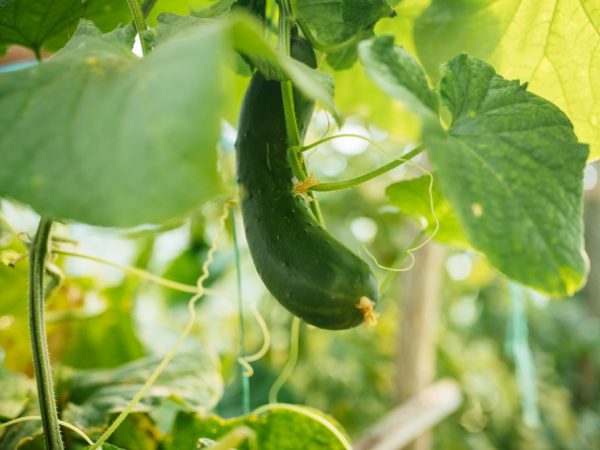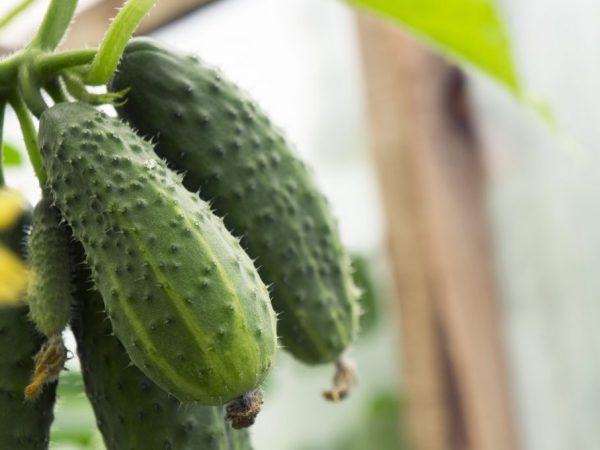Why cucumbers have an irregular shape
When growing a cucumber crop in a greenhouse or in open ground, some summer residents wonder why cucumbers have an irregular shape: either the vegetables are crooked, then they grow in the form of an uneven pear, or they turn out to be pot-bellied and hook-shaped. It turns out that in order to get even fruits, it is not enough to plant seedlings in a greenhouse. It is necessary to eliminate the causes of the formation of irregular cucumbers, including providing proper care, adequate nutrition, the required agricultural technology and timely harvesting.

Causes of the irregular shape of cucumbers
Improper nutrition
Improperly selected mineral nutrition, when vegetables lack useful components, can also be the reason why cucumbers grow in curves, of irregular shape.
Lack of potassium
The lack of a trace element responsible for the formation of cucumber fruits is one of the most common reasons for the change and curvature of the shape of cucumbers. Failure to add potassium at the stage of flowering and before direct fruiting leads to potassium starvation of plants, as a result of which a narrow "bottom" begins to form in the fruit and the lower part of the fruit is rather wide in comparison with it. The deformation of the pear-shaped cucumbers, when there is not enough potassium, is also accompanied by the appearance of a yellow border at the edges of the leaf blades.
Recommendations
It is possible to increase the potassium content in the soil by introducing root dressing with an ash content. 1-1.5 l of ash powder is dissolved in a 10-liter volume of water, kept for several days until a concentrate is obtained, and the concentrated mixture is diluted with water in a ratio of 1:10 l.
To replenish the lack of potassium, you can use ready-made fertilizers that have the desired component in their composition. Potassium sulfate is diluted at the rate of 3-4 large spoons per 10 liters of water and watered cucumber bushes with a consumption rate of 0.5 liters for each seedling.
To correct the situation so that vegetables change their appearance in time and become classically straight, you can use additional foliar feeding, which is carried out with preparations containing potassium with a concentration of 2 times less than when watering.
Lack of nitrogen
When the foliage on a cucumber bush changes color and begins to fade, and the fruit is crooked or has a wide base and a narrow end, these are signs that the vegetable crop is lacking in nitrogen.
Recommendations
To saturate the soil with nitrogen-containing components allows chicken manure or herbal infusions.
Chicken manure is used in the form of compost prepared with peat, sawdust and straw in 1.5-2 months, or in liquid form when it is diluted with water 50/50 and left to stand for 2-3 days. Concentrated solutions are diluted with water in a ratio of 1:10 and the aisles are watered with working fluid.
Among the suitable herbs for the preparation of solutions, nettle is isolated, the foliage and stems of which are crushed, poured with water and fermented for 7-14 days, diluted again with water in a ratio of 1:10 for irrigation or 1:20 for spraying with foliar feeding and used at intervals of 2 weeks until the state of the cucumber plantings improves.
Violation of agricultural technology
One of the main reasons why cucumbers are crocheted and become pear-shaped is a violation of the rules of cultivation of cucumber crops.
Crop rotation
Planted after pumpkin crops, strawberries, eggplants and tomatoes, taking all the potassium from the soil, cucumbers grow irregularly shaped: they become pear-shaped or hooked.
Recommendations
In conditions of limited cultivated areas, the fertility of the soil can be replenished by planting before late planting of green manure cucumbers. The most potash green fertilizer of all green manure is considered to be oats.
Unsuitable varieties

The reason for the deformation of the fruit is often an incorrectly selected variety.
Cucumbers bend, become round or curl if the variety is chosen incorrectly: it does not fit the description for a particular season. So, light-loving and thermophilic varieties by the end of the summer period will necessarily begin to respond to a decrease in ambient temperature and a decrease in daylight hours, which will cause them to change their shape.
Recommendations
Early varieties of cucumbers that love light and warmth need to be planted a little earlier and harvested until the end of August.
In terms of the percentage of potential formation of ugly vegetables, Twixy, Paratunk and Othello hybrids are least likely to appear. From Patty, Champion and Little Boy by the end of August, in 100% of cases, it will be possible to get curved fruits with a thin stalk or an ugly shape.
Wrong neighborhood
Do not plant next to each other, especially in a closed greenhouse, pollinated and parthenocarpic varieties of cucumbers. Parthenocarpic varieties are intended for cultivation mainly indoors, as hybrids form an ovary without pollination. But when their flowers in the vicinity of inflorescences of classic varieties attract pollinating insects, in most cases this leads to deformation of the fruit and the growth of irregular cucumbers.
Recommendations
Neighboring varieties, while saving the cultivated area, are isolated from each other with a non-woven covering material. Also, when growing hybrid varieties, you should not often open the vents in the greenhouse, so as not to attract insects and eliminate the risk of over-pollination of parthenocarpic varieties with other varieties.
Violation of the rules of care
Improper care of cucumber plantings can cause deformation of cucumbers.
Thermal conditions
Too low temperature or indicators above 30-35 ° C lead to a decrease in the digestibility of potassium by the cucumber crop, as a result of which the shape of the cucumbers changes.
Recommendations
In hot times of the day, regular ventilation of the closed greenhouse is required. Some summer residents whiten the roof of the greenhouses for the summer season so that a lot of sunlight does not pass through it. Barrels of water installed in the daytime help to save cucumber bushes from the cool weather at night, which during the day absorb heat, giving it away on a cool night.
When growing cucumbers on open soil, mini-greenhouses are installed to protect from the coolness. Covering materials are used from excessive heat and create a shade.
Watering
Failure to comply with the rules of watering in a situation where the soil has been dry for a long time leads to the fact that the cucumbers grow in a crochet and are deformed.
The wrong shape is obtained in cucumbers and when watering a vegetable crop with too cold water. In this case, screeds form in the middle of the vegetables and the cucumbers look like curved barrels.
Recommendations
So that the shape of the cucumber does not twist into a hook and the vegetables do not taste bitter, when watering they use water not lower than 18 ° C.
Late harvest
The wrong harvest of cucumbers is also able to affect the further change in the shape of future fruits. The overgrowths present on the cucumber lash not only lose their taste characteristics, but also inhibit the further development of young vegetables, disrupting the supply of full-fledged mineral nutrition to them, as a result of which a completely different shape is obtained from what a classic cucumber should have.
It is recommended to harvest a cucumber crop at least once a day in order to provide young green people with the opportunity to feed.
In the case when it is not possible to maintain the picking of the cucumber crop with the proper frequency, experienced gardeners recommend removing vegetables at least once every 2-3 days all at once - from fully ripe to small gherkins that have grown up to 4 cm.When collecting a cucumber crop, it is worth paying attention to the quality of cucumber lashes:
- it is important that they do not break or rot,
- old ones that have begun to dry out should be removed,
- Do not leave green plants with signs of pathology and diseases.


